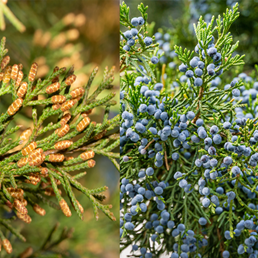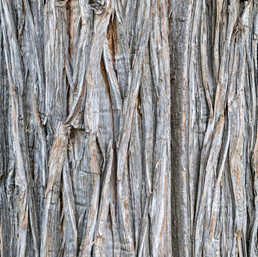There may be no tree that can grow naturally in so many different types of climates in the Northern hemisphere than the juniper.
With roughly 60 different species available -- ranging from low-growing groundcovers to shrubs to full-size trees that can grow as high as 130 feet, species from this member of the cypress family can grow in arctic climates, as well as deserts.
And it’s a winner in your home landscape because it’s easy to grow, very hardy, and provides year-round ornamental interest.
Think you have a juniper in your yard or maybe you’re looking for a tree you’d like to plant? Let’s look at juniper tree varieties and tips you can use to best identify juniper trees and care for them.
How to Identify a Juniper Tree
Juniper tree varieties come in a variety of shades -- from deep to silvery greens and then shades of blue, bronze, and even gold.

As a coniferous evergreen, juniper leaves start out rough, prickly, and needle-like, but soften as they mature into flattened, scale-like foliage. Depending on the species you choose, junipers can have an upright, spreading, or weeping habit, and can range in size from 6 inches to 130 feet tall and a spread range from 1 to 25 feet. Tall varieties with thick foliage can make great windbreaks.
Types of Juniper Trees
What does a juniper tree look like? Let’s take a look at some common types of junipers.
Eastern red cedar (Juniperus virginiana) - Found in eastern North America in zones 2 to 9, red cedar is an especially fragrant form of juniper with dark blue-green foliage and gray to reddish-brown bark. It can grow 30 to 40 feet tall and enjoys full sun. While it tolerates moisture well, it does not like soggy soil.
California juniper - This favorite for creating wildlife habitats and drought-tolerant landscapes in the Southwest U.S. features scale-like blue-gray leaves and reddish-brown cones. This juniper is tolerant of alkaline soils and growing 10 to 15 feet tall in zones 8 to 10 has also been used in bonsai.
Common juniper - This common sun-loving shrub is widely distributed on rocky soils throughout the Northern Hemisphere. Working well in both acidic and alkaline soils, this juniper is one of the rare ones that has needle-like leaves rather than scales. Growing in zones 3 to 8, it matures to around 15 feet tall, sometimes reaching 30 feet.
Creeping juniper - This juniper works well as a groundcover, with many varieties having yellow foliage and producing blue-white berries. In full sun in zones 3 to 9 is where this juniper grows.
Greek juniper - Growing in zones 5 to 9, this hardy tree can reach 20 to 65 feet tall in full sun. Sometimes growing massive trunks -- up to 6 feet diameter -- the Greek juniper has gray-green foliage and purple-blue berries.

What Do Juniper Tree Cones Look Like?
A helpful way to perfect juniper tree identification is by looking at its cones.
Juniper cones on male trees are small and either yellow or tan.
The female plants produce colorful berries, which are actually modified cones. Northwest species berries turn blue at maturity, but some species have red berries. Berries can attract birds and other wildlife.

Juniper Tree Bark
Juniper tree bark is attractive. Some varieties even have oddly-twisted branches giving them unique ornamental appeal.
Juniper wood on some species is considered very fragrant, and this uniquely aromatic characteristic is how many identify juniper trees.
How to Care for Juniper Tree
- Grow zones: Most junipers are hardy in USDA zones 2 through 10, with the majority of the species being hardy in zones 4 to 10.
- Where to plant: Junipers like slightly acidic pH soils, but will grow in non-acidic soils as long as they receive good drainage.
- Height/spread: Depending on the species you choose, junipers can have an upright, spreading, or weeping habit, and can range in size from 6 inches to 130 feet tall and a spread range from 1 to 25 feet.
- Sunlight: Most junipers prefer full sun. In warmer climate areas, some juniper tree varieties prefer a bit of afternoon shade during the hottest parts of the day, particularly in the summer. They need about six hours of direct sun each day so foliage density isn’t compromised.
- Flowering dates: In spring, junipers can produce tiny yellow or green flowers. Some juniper tree varieties self-pollinate, producing both male and female blooms, while others require a male and female juniper for pollination.
- Best time to prune: You can prune tips of branches each year to keep plants in check size-wise. But if you provide enough space for a juniper to grow to its mature size, no pruning is necessary. Prune junipers in late winter and early spring just before growth begins.
- Deer resistance: Since junipers often give off a heavy fragrance and deer are sensitive to smell, they tend to avoid junipers.
Potential Threats
Junipers are relatively low-maintenance plants when properly placed in the right location and given adequate care. However, improperly planted junipers can suffer extra stress resulting in browning needles and even entire shoot dieback.
During warm, wet weather, junipers can suffer twig and tip blights caused by fungi. This browning of needles on the oldest, lowest branches can be caused by other issues, such as drought or overwatering, so closely inspecting plants is important for diagnosis. Purchasing disease-resistant juniper tree varieties can help avoid this problem, as well as avoiding poor placement in shaded or poorly drained locations. If a fungal blight is present, promptly prune and remove any diseased or browning branches as they occur. Your tree care professional can use a fungicide as well; an experienced eye is essential since timing is crucial.
When it comes to pests, scales and spider mites can be troublesome on junipers. Their damage appears as tiny yellow spots on needles, and eventually browning needles and needle drop. Your local arborist can inspect the tree and identify your pest problem, suggesting a treatment solution.





